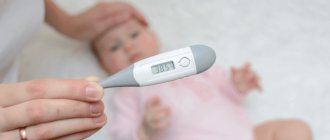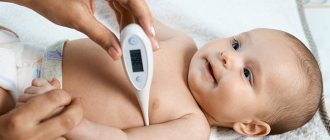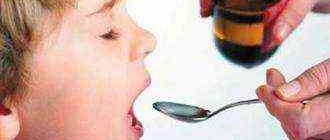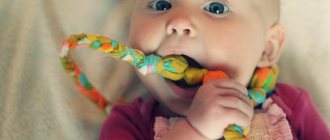A rash in a child is a fairly common occurrence. In many cases, it does not require treatment, for example, the so-called newborn acne occurs in every fourth baby and goes away on its own. We provided detailed information about all types of rashes in this article, and we talked about rashes that are localized specifically on the arms and legs here. In this article we will look at those cases when the appearance of a rash is accompanied by a high temperature.
Insect bites
Sometimes a rash with fever can be a consequence of the fact that the child has been bitten by some insects, for example, poisonous midges. The increase in temperature will be insignificant. It is due to the fact that the immune system fights the poison that has entered the body, which is why such a reaction can occur. In this case, you will notice that the child is bothered by itching. Your baby will be itchy all the time and appear more restless than usual.
Often, a small rash appears on the body in newly born children. Most often it does not require treatment and soon goes away on its own.
What to do?
Those areas of the body where you see bites can be treated with Psilobalm or Fenistil-gel. They will eliminate the itching. To prevent the appearance of peeling, you can apply a body moisturizer over the medicine, but it is better to do this no earlier than 15 minutes after applying the medicine. If the fever is very high, give your child an antihistamine and some kind of fever-reducing medicine.
Probable Causes
If a rash and itching appears in a child, doctors identify several main
Rash on baby's body
reasons for these symptoms:
- sweat rash,
- an allergic reaction of the body to a food product or household chemicals,
- viral diseases,
- bacterial diseases.
The first two reasons, as a rule, do not cause an increase in temperature. In this case, the rash on the child’s body is itchy without fever. If the baby has a fever against the background of the rash, overheating is most likely occurring. To alleviate the baby’s condition, you need to remove excess clothes from him and let his body “breathe.”
Infectious diseases
Infectious diseases such as measles, chickenpox, scarlet fever, rubella are traditionally called childhood diseases. Indeed, they most often occur in childhood. And that's even better. According to doctors, a child’s immune system is more flexible than that of an adult, and therefore it is easier for him to endure a severe infection than a teenager, an elderly person, and especially a pregnant woman. Let's consider what signs can be used to identify a particular disease caused by an infection.
If the rash appears along with a high fever, it is highly likely that the child has an infectious disease
Chickenpox
Chickenpox is the most common infectious disease. 85% of the population gets it in childhood. Here are its distinctive features:
- rashes look like blisters filled with liquid;
- in appearance they resemble mosquito bites;
- at first there are few of them, gradually the number increases;
- blisters are located throughout the body: on the head, face, back, stomach and even on the mucous membranes;
- as the disease develops, the blisters shrink, become covered with a crust, which then falls off, leaving no marks on the skin (unless it is deliberately torn off ahead of time);
- the rash is accompanied by itching, so the doctor may prescribe antihistamines;
- The “contagiousness” of chickenpox lasts 2 weeks.
Erythema infectiosum
Children of the younger age category are more susceptible to this disease. The disease is the result of epidemics that periodically occur in children's educational institutions. The signs are as follows:
- deterioration in general health;
- temperature increase;
- lethargy and weakness;
- headaches;
- runny nose.
The rash affects the child's cheeks. Initially, it is represented by small dots of bright red color, which subsequently increase and form certain patterns on the skin. Subsequently, the rashes spread throughout the body, in some areas of which they may be accompanied by swelling.
Normalization of the child’s condition occurs after a week from the onset of the disease. During the month, small rashes are possible, the appearance of which is provoked by the body’s strong exposure to stress, mechanical or physical stress. During treatment the following are required:
- bed rest;
- drinking plenty of water;
- maintaining hygiene.
Measles
This disease is much less common today than chickenpox because many children are vaccinated against measles. Its features are as follows:
- At first, only fever appears, there are no rashes on the skin.
- But there is conjunctivitis, cough and runny nose, the child becomes lethargic, his malaise is visible, which is why in the first three days measles can be confused with a common cold.
- The rash appears on the third day. At the same time, there is a sharp increase in temperature again.
- First of all, rashes in the form of red pimples appear on the face. Gradually they spread to the chest, stomach, back, arms and legs.
- After 3 days, the pimples disappear, but traces of their presence still remain on the skin: peeling and pigmentation.
Many diseases of an infectious nature are accompanied by the appearance of a rash, high fever and general malaise.
Rubella
Rubella is a disease that must be suffered in childhood, especially for girls. If you contract this infection during pregnancy, it can lead to serious defects in the development of the fetus. Rubella has the following symptoms:
- rashes without itching are a small rash;
- at the very beginning, the child feels unwell and weak, like during a cold;
- You may feel body aches and have a runny nose;
- the temperature lasts only the first 2 days, after 4-5 days all other symptoms disappear;
- the appearance of a rash is accompanied by pain in the eyes;
- The occipital lymph nodes are enlarged.
Scarlet fever
You can also read:Acne in children
The causative agent of this disease is streptococcus. Scarlet fever can be distinguished from other infectious diseases by the following characteristics:
- the first symptoms are similar to those that appear with a sore throat: the tonsils become enlarged, the mucous membrane turns red;
- you may notice redness of the tongue (pediatricians call this phenomenon “raspberry tongue”);
- the child feels acute malaise and weakness;
- the rash appears simultaneously with the fever. More often this happens either at the end of the first day or at the beginning of the second;
- the first rash appears on the face, while the nasolabial triangle remains clean, then redness appears on the neck, then spreads throughout the body;
- there are especially many rashes on the inner thighs, in the folds of the skin of the armpits, and on the lower abdomen;
- Symptoms last for a week, but a child is considered contagious for 21 days. At this time he needs to be isolated from society.
Etiology of rash with fever
Rash near the mouth of a child
There are quite a few pathologies in which first a high temperature occurs, then a rash in the child. Sometimes even doctors cannot determine by the nature of the rash what kind of disease caused it. In such cases, additional tests need to be performed. A rash with fever can be associated with a number of pathologies.
Allergic reactions
These types of rashes, as a rule, do not have a clear localization. They can appear in different parts of the body. An allergic rash is often accompanied by itching. To alleviate the patient's condition, the doctor prescribes sedatives and antihistamines.
To restore a child’s health, it is necessary to exclude the allergen that caused this reaction from his diet. To remove the allergen from the body, sorbents are prescribed (these are Polysorb, Laktofiltrum, Smecta, Polyphepan, Filtrum, Zoosterin-ultra, Enterosgel). Also, antiallergic medications will not be superfluous: Suprastin, Diazolin, Loratadine, Terfen, Erius. You should not self-medicate; only an experienced allergist can choose the right regimen and dosage of medication for your child.
Prickly heat
This is a rash that occurs in newborns during the warm season or when tightly wrapped in clothing. The main reason for this condition is difficulty in releasing sweat and increased humidity when wrapped. Miliaria often occurs in areas of diaper rash. This type of rash causes severe discomfort in the baby. With proper care it goes away quite quickly.
Viral pathologies
The most common viral pathologies with skin rashes are:
- Measles. A highly contagious infection. The rash appears 2-4 days after the temperature rises, swelling, redness and white coating on the mucous membrane of the throat, rhinitis and cough occur. The rash first forms on the face, neck, then on the limbs, shoulders and abdomen.
With measles, body temperature rises to 38-40 °C
- Rubella. The rash appears as numerous small spots that literally cover the baby’s entire body within a few hours. In this case, the body temperature can rise to 40 degrees, the cervical lymph nodes become greatly enlarged, and intoxication of the body is observed.
- Infectious mononucleosis. The etiology of the disease is associated with herpes viral infection. The main signs of the disease include lymphadenitis, hyperthermia and hypertrophy of the spleen and liver. A rash with mononucleosis is very rare.
- Infantile roseola. An infectious disease caused by a group of herpes viruses types 6 and 7. At the initial stages of pathogenesis, hyperthermia, pharyngitis and hypertrophy of the lymph nodes are observed. After 2-3 days, small pimples appear on the baby’s body, which resemble a rubella rash.
Note. Very often, a rash with roseola is mistaken for allergic manifestations to antipyretic drugs.
- Chickenpox. First, the rash forms on the scalp. Later, the rash covers almost the entire body. The appearance of a chickenpox rash is accompanied by severe itching. Every day more and more new spots appear, old ones turn first into papules, then into bubbles with transparent contents.
Bacterial infections
Doctors also identify a number of pathologies of a bacterial nature, some of the signs of which are rash and fever:
- Scarlet fever. The causative agent of this disease is streptococcus. The disease is transmitted by airborne droplets. A distinctive feature of scarlet fever is a clear nasolabial triangle, while the entire body is covered with a pinpoint rash. Characteristic rashes on the body (elbows, abdomen, inguinal folds, armpits) usually appear on the second day after the onset of fever.
- Meningococcal infection. An extremely dangerous pathology with a high mortality rate. As the disease develops, the following signs may be observed: hyperthermia, nausea, vomiting, diarrhea, confusion, paresis of the occipital muscles, the child cannot reach his chin to the chest.
Advice. If a meningococcal infection is suspected, the child should be immediately taken to an infectious diseases hospital.
Non-infectious causes of rash
The most common causes of rash include the following:
- Eczema (atopic dermatitis). This is a fairly common disease that is often diagnosed in young and middle-aged children. It causes red, itchy rashes on the inside of the elbows and the back of the knees, as well as on the cheeks, neck, wrists and ankles. Eczema is often observed in patients who have hay fever or bronchial asthma.
- Toxic erythema. The rash with this problem goes away within 5-7 days. It is harmless, so there is no need to worry; you can do without treatment. The rash begins on the face and then spreads throughout the body, without affecting the palms and soles of the feet.
- Scabies. A parasitic disease caused by the scabies mite. The rash appears between the fingers, in the groin area, on the wrists, legs and buttocks. It is accompanied by severe itching, hyperemia and pain.
- Acne of newborns. The rash usually appears in the first weeks of a baby's life. It recurs periodically over several months.
What can cause a rash?
A red rash on a child’s body can also appear after insect bites (mosquitoes, poisonous midges, bedbugs, etc.). This phenomenon may be accompanied by a slight rise in temperature.
A child has a rash and fever: what to do?
If your child has a rash accompanied by fever, diarrhea, and other related symptoms, follow these guidelines:
- Isolate your baby from others. Only one family member should be involved in his treatment.
- There is no need to go to the hospital - the presence of a high temperature is a reason to call a doctor at home, and also prevents infection of others.
- If you are close to pregnant women, do not allow them to come into contact with a sick child.
- Until the doctor arrives, do not treat the rash with any medications, especially dyes: brilliant green, manganese solution, iodine. This may prevent your doctor from making a correct diagnosis.
- If vascular spots appear on the body (they most often appear on the legs), provide the child with bed rest.
- Remember: every infection is fraught with complications, so treatment must be prescribed by a pediatrician.
Rash due to meningococcal infection
Viral and bacterial diseases
Viral diseases
The invasion of pathogenic microorganisms into the baby’s body is always accompanied by an increase in temperature. If you suspect a viral or infectious disease, you should consult a doctor.
After all, such ailments include the following diseases:
- Chickenpox.
- Rubella.
- Measles.
- Herpes.
- Scarlet fever.
- Meningococcal sepsis.
If the temperature has risen and the child’s body itches, it is necessary to evaluate the nature of the rash. For each disease, the number of pimples and the area where they are located is individual. The symptoms of the diseases also differ.
Chickenpox
If a baby is infected with chickenpox, the temperature initially rises to 38-
Healthy baby
390С. The general condition worsens, weakness appears. Following the appearance of these symptoms, a rash forms on the body, which at first looks like small red spots that turn into blisters after a couple of days. As the disease progresses, the number of blisters on the body increases, causing discomfort to the child.
Rubella
If itching is detected on the child’s body and fever, which appear almost simultaneously, the doctor can diagnose rubella. The peculiarity of this disease is the rapid spread of the rash throughout the body and its contagiousness. For treatment, the child is isolated and appropriate therapy is carried out. For children, rubella does not pose a great danger, but for pregnant women, infection with this disease threatens the loss of the fetus.
Measles
If a child has a fever and itchy body, what should you do? Of course, consult a doctor. If the temperature rises sharply, accompanied by a runny nose, cough and the appearance of rashes and itching all over the body, it is likely that the baby has become infected with measles. Over time, the rash forms a single red spot that is very itchy. Modern medicine recommends that children be vaccinated against measles, since the disease is difficult to tolerate and causes a number of negative consequences.
Herpes
This viral infection is the most harmless among all those mentioned. The disease often affects children under two years of age. The disease begins acutely with an increase in temperature. After a few days, the fever subsides and a rash forms on the body, which can be itchy. The rash goes away on its own without the use of any medications after 3-4 days.
Most rarely, modern children suffer from meningococcal sepsis and scarlet fever. IN
Seeing a doctor
In the first case, medical care is required during the first hours of infection. If these hours are missed and medical care is not provided, the patient will die.
Scarlet fever is manifested by a rash on the body, itching, fever, and a painful red throat. This disease is treated with a good prognosis for the child’s life. However, if therapy is not started in a timely manner, scarlet fever can cause complications in the renal and cardiac systems.
Treatment
The presence of a rash accompanied by a high temperature is a reason to consult a pediatrician. In this case, you should not self-medicate, just as you should not leave everything to chance. If rubella, in principle, does not require special treatment and goes away on its own, then scarlet fever, on the contrary, without taking antibiotics is fraught with complications that will primarily affect the baby’s kidneys and heart. Any disease of infectious etymology should develop under medical supervision.
When the rash is accompanied by an increase in temperature, we can talk about a serious infectious disease, the development of which must necessarily occur under the supervision of a pediatrician. However, a rash with fever may also be a manifestation of an allergy or a consequence of the child being bitten by insects. Pay attention to general symptoms and, if treatment is necessary, discuss it with your doctor.








